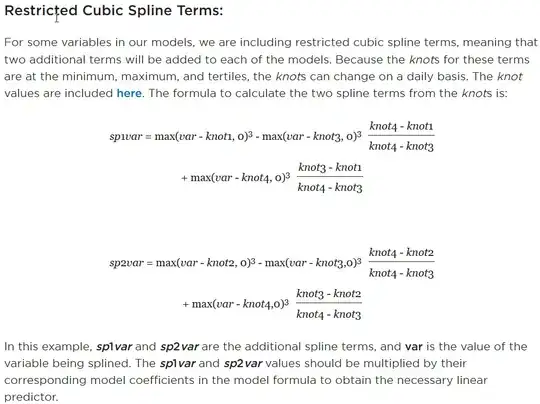I try to calculate spline terms of a logistic regression to generate a linear predictor/ prediction formula for the model "Lymph Node Involvement (Cores)"
The source (https://www.mskcc.org/nomograms/prostate/pre_op/coefficients) states the forumula to calculate the spline terms sp1var and sp2var as follows:
I tried to calculate sp1var and sp2var using the published knots in R:
var=10 # PSA = 10 for example
knot1= 0.2
knot2=4.7
knot3=7.2
knot4=96.53
sp1var <- max (var -knot1)^3 - max(var-knot3)^3 * ((knot4 - knot1)/(knot4-knot3)) + max(var - knot4)^3 * ((knot3 - knot1) / (knot4-knot3))
sp2var <- max (var -knot2)^3 - max(var-knot3)^3 * ((knot3 - knot2)/(knot4-knot3)) + max(var - knot4)^3 * ((knot3 - knot2) / (knot4-knot3))
however, If I calculate the probability (according to Make prediction equation from logistic regression coefficients), I get a wrong result:
# define the Intercept
Intercept = -5.37368223
# define the Coefficients
cAGE = 0.00906354
cPSA = 0.21239809
cPSAs1 =-0.00132481
cPSAs2 = 0.00356913
cGLE = 3.03232465 #for gleason grade 5
cCLI = 0.71055042 #for clinical stage 3+
cPOS = 0.05499551 # no. of positive cores
cNEG = -0.11987793 # no. of negative cores
# define predictors
PSA= 10
age=50
npos=10 # no. of positive cores
nneg=10 # no. of negative cores
# calculate the probability
z = Intercept + age * cAGE + PSA * cPSA + sp1var * cPSAs1 + sp2var * cPSAs2 + cGLE + cCLI + npos *cPOS + nneg * cNEG
exp(z)/(1 + exp (z))
# result : 0.8962046
# expected: 0.39 (https://www.mskcc.org/nomograms/prostate/pre_op)
Do I misinterpret the stated formulas?

